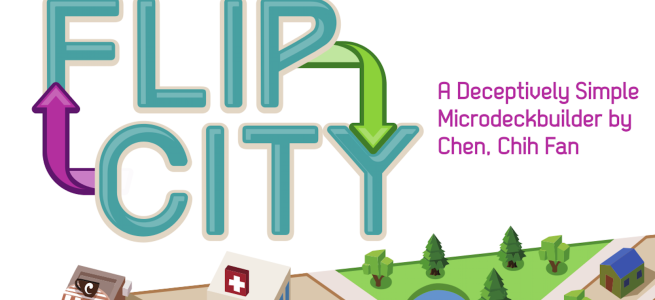Introduction
“Winning” as a feature is nearly ubiquitous in games. Very few activities that might be described as “games” go without a win-condition and those that do are considered by many gamers and designers as not games. A good example of a game without win conditions is Rory’s Story Cubes. It has a variety of ways to play and they are very entertaining. But if you want a win-condition, you have to impose one.
Most games however, have win (or lose) conditions as an explicit feature. In Chess, your win condition is capturing the enemy king. In Monopoly, to be the last player with money. In Coup, to be the last player with a face-down card and in Charterstone, the win condition is to be the player with the most victory points at the end of the game. Unlike the other games mentioned, Charterstone’s victory points are one-step detached from the actions of the game itself (collecting resources, building, opening crates and so on). Victory points are an abstract representation of “how well” you are doing. In chess, you know how well you are doing based on how many pieces you have in relation to your opponent and your general positions of those pieces. In monopoly, you can judge your success based on how much money and how many properties you have relative to your opponents and in Coup, how many players still have cards.
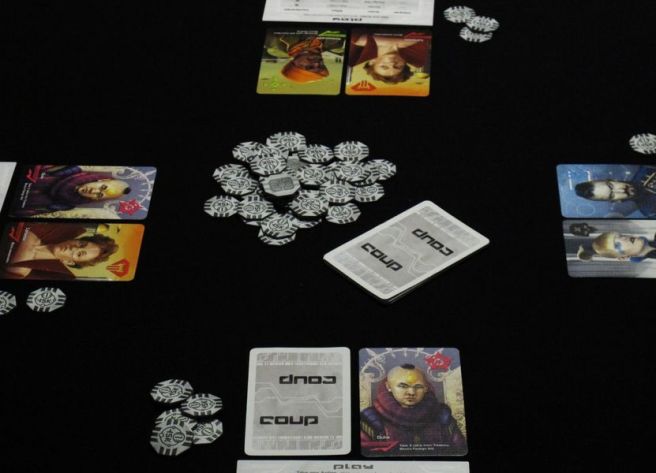
Charterstone’s VPs however, are a little different. They do communicate how well you are doing relative to the other players, but the link between your game actions is slightly disconnected, or abstracted. Players build a representation, or sense, of how their actions build VPs, but unlike the other games, the actions themselves are not that communication. In my own play of Charterstone, I have struggled to beat even the autonoma because I do not have a good sense of VPs and their connection to the actions of the game. More experienced euro-game players have more developed senses or feels for this representation and probably don’t experience the same difficulty I have.
As a teacher, this indirect relationship between VPs and game actions raises some pedagogical questions when attempting to use games for learning. In this essay, I intend to explore those pedagogical questions through the game Flip City. In particular, I will interrogate:
1) What is the relationship of Flip city’s assets to victory points and win conditions?
2) How can that relationship hinder and/or be leveraged for L2TL?
I’ll start by detailing the assets in Flip City and their direct or indirect relation to the win conditions. Then, I will discuss how theme, assets and win conditions can obscure cultural messages and finally, how a game-design enhanced sociocultural approach to L2TL can illuminate the game actions, rules and underlying cultural values.
Flip City
Flip City is described as “a deceptively simple microdeckbuilder” by the designer Chen, Chih Fan. It plays between 1 and 4 players in about 30 to 60 minutes. In the game,you take on the role of…. mayor? city council? city planner? the government? Probably all of these things and your goal is to build, expand and improve your city. Before I jump into an analysis of the mechanics and theme, here is a rundown of how to play Flip City by “Watch It Played”
Mechanics
The mechanics are straight-forward deckbuilding. You start with a few cards that compose your deck and play cards one-at-a-time, in the order they appear at the top of that deck. This mechanic interacts with a push-your-luck feature to build assets (coins) in which you use to buy new cards and upgrade your existing deck. A player wins when they achieve a certain number of VPs or are able to play 18 cards in one turn.
The Deck

Each player starts with the same nine cards: 4 residential areas, 1 apartment, 1 factory, 1 convenience store, 1 hospital and 1 central park. Players shuffle these cards and keep them in a tight deck so that only the top card can be seen. On their turn, players play their cards one at a time until they want to stop and move to the building/developing phase.
Push your luck
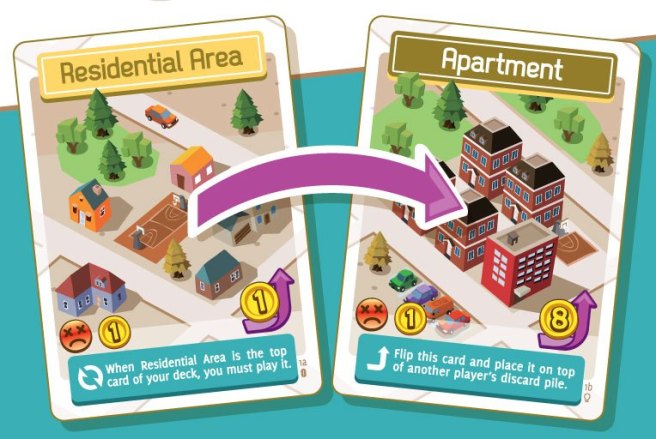
But, while you are playing cards, you must be careful that you don’t play three cards that have a small red, angry face in the bottom left part of the card. If you do play three angry face cards, then your turn immediately ends and you cannot use the assets you had gained during your turn to buy new cards or develop old ones. Game strategy revolves around knowing how to predict and mitigate the angry-face cards in your deck.
Buying
After you play your cards, you can choose to buy a new card from the marketplace, which includes more of the same cards you have in your hand, excepting the residential areas and apartments. By buying new cards, you can use the assets from those cards in your future turns to continue buying and developing cards.
Developing
The final mechanic involves the title mechanic, flipping cards. After you end a turn, all the cards you played during that turn go into a discard pile. On your next turn, after you play cards in your building phase, instead of purchasing a new card, you can instead choose to flip a card, for a certain cost, in your discard pile. A flipped card is a more powerful version of the original card and will provide you more assets that can be leveraged towards finally winning the game.
There is a final mechanic, which I won’t talk about here, called “recycle”. You can recycle any flipped card that is in your discard pile to receive some benefit.
Theming
Deck-building and city-building
As a city manager/government, your deck represents the mixture of possible resources and taxes you can leverage to build and improve your city. The fact that all players start with the exact same cards is an interesting note about city planning. It suggests there are fundamental pieces to building a city and each card represents those fundamentals.
The game calls the card-playing phase the “build phase”, but this is maybe a slight thematic disconnect. It does make sense that by playing cards, you are “building up” a city over time, however the goal of the build phase is to collect coins and to avoid angry faces. In the description of the game, they note that this is a “tax” collecting phase. On the back of the box it says, “the citizens of Flip City want you to expand and renovate their neighborhoods — but if you ask for too much in taxes all at once, they won’t be happy!” The angry faces on the cards then, represent how your citizens feel about being taxed. In many ways then, one of your primary roles as the player is tax collector, which is brilliant. However, it is masked by the “build” language. This strangeness in the tax / build theme is, I think, something the game designers also feel. Where the back of the box talks about “taxes”, the rules manual says, “build and improve your city – but beware, because too much construction can make your citizens unhappy!”
After collecting taxes, represented by the coins on the cards you built, you become city council / mayor and decide what would be the best way to use your taxes by investing in new buildings. The cards in the marketplace represent: 1) industrial production (factories) 2) goods and services (convenience stores) 3) public health and safety (hospitals) and 4) Public services (central parks). The final card, the residential area is not available in the marketplace but quite obviously represents housing. Thematically, these city categories fit well into other city-building game themes like Sim City.
Taxes, city zoning and “buying / developing”
The relationship of these city categories is also fairly well tied to the theme of taxation and citizen unhappiness. By playing a commercial building, you are able to tax 1 coin, an industrial card gives you 2 coins. This simple relationship indexes a very normal view of city development. Many cities are built on the foundation of one industry in particular. In my hometown, that industry is coal mining. The service sector in my town developed to provide additional services to the citizens, who primarily come to work in the mines. Public services in contrast, do not give players any coins for very good thematic reasons. How can the government tax the government? Public health and safety however is taxed. Indicating that maybe the healthcare policy in our little town is profit-based.
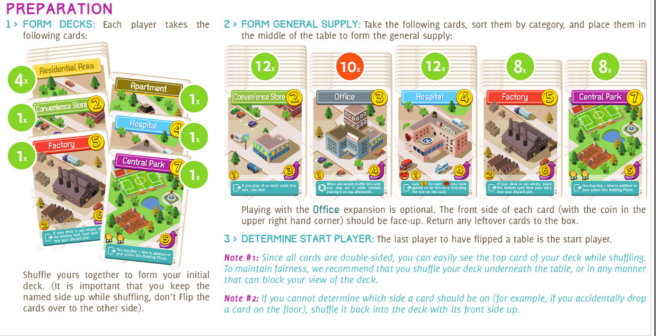
Residential areas (RA) also give 1 coin, but also 1 unhappiness. Property taxes are often unpopular, but this brings up an interesting comparison with the industrial and commercial taxes. Why are residents the ones who provide unhappiness? Why not the convenience stores? This is more of a game-design choice than a thematic one. Not all cards can have unhappiness, otherwise the game is broken, so a choice is made. The other card that gives unhappiness is the hospital, or public health and safety category. I quite like this thematically. Public health services are necessary, though when you need them, it is usually because something bad or traumatic is happening. That unhappiness has a twist though, because when a player builds the hospital, all previous unhappiness that had been gained on your turn, is now also worth one coin.
The Flip
When a player chooses to develop their cards and flip them, the theme can get a bit interesting. RAs become apartment complexes, but still provide 1 unhappiness and 1 coin. The only difference is in the card-specific rule which states that when a RA is your top card, you MUST play it. Apartments in contrast, do not have to be played when they are your top card. Strategically, this is a big deal and in my own games one of my first goals is to flip all of my RAs into apartments, so as to avoid the punishing effects of unhappiness.
Convenience stores become shopping malls and provide 2 coins and 1 VP. Central Parks become Stations and they provide 3 VPs instead of 2. Factories become Power Plants and they provide only 1 coin, but also 2 VP and also 1 unhappiness because of… pollution? If so, one wonders why the factory doesn’t also have unhappiness. Finally, hospitals become churches and they provide no money, no unhappiness, but they allow you to support 1 more unhappiness (4 instead of 3). Thematically, I have little understanding why this is the case, but perhaps because many hospitals are run by religious organizations, there is a connection there.
For the most part, I really enjoy Flip City’s theme and its relationship to the mechanics. Like most city building coins, there are references to managing your city’s money and your citizen’s happiness. The theme helps make the “push your luck” and buying/developing mechanics sensible and easy to learn.
Victory Points
Because the theme-mechanic relationship is quite good in Flip City, the VP asset is very noticeable. Where coins and unhappiness are fairly intuitive, VPs can be hard to describe. Luckily, because you only need 8 VPs to win, and because there are only three different cards that give VPs, it is fairly obvious what you need to do to win the game: build shopping malls, parks, stations and power plants, all the while managing your unhappiness. This is, in my experience, different than the VPs in a game like Charterstone. Because games will go into the 50s and 60s of VPs and because there are so many different ways to earn VPs (and the motivations change game to game), it isn’t quite so clear.
What the problem is and isn’t
VPs in games serve an important purpose. As a resource, they indicate to the player that they are either doing well or poorly. This sense of progression is useful to players. In Flip City, your first building turns will likely have 0 to 1 VPs, later you will probably play a 4 to 5 VP building turn. As you continue to buy and develop, you will see more and more VPs appear until you eventually manage to play the 8 required to win. VPs sign-post to the player very clearly how they are doing.
Thematically abstracted VPs can confuse what the new player might expect. This confusion lies in the relationship of a persons previous concepts related to: 1) the world 2) social concepts about the world 3) game design concepts. Experienced players have developed a series of representations of VPs in their mind that tie to expected game mechanics. As long as new players continue to play and build up the representation of the VP in relation to the game their minds, they will come to understand how game design, actions and VPs are related in the game.
However, when trying to teach a game, the obscure VP may be a demotivating feature of play. Players who are new or maybe just curious about the game may not really feel the sense of progression simply because they see the VP or they may not see the connection between playing specific cards and why they have VPs. In Charterstone this caused significant demotivation for me. In the case of Flip City, my first games were a series of remembering what cards awarded VPs and which didn’t. When I play Flip City now, I like to think of the VPs as something like civilization’s “amenities”, which provide happiness for citizens (which seems like an intuitive concept in contradistinction to Flip City’s “unhappiness”).
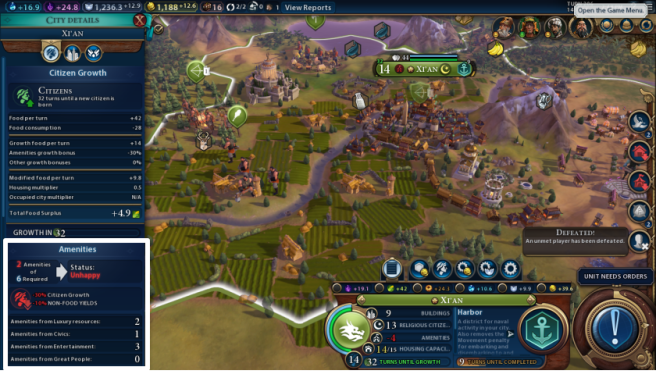
As a teacher then, an important part of making sure learners build the appropriate representation of what the VP is in the game is an important step towards understanding the game conceptually and also transferring that conceptual understanding to the real world. In the next section, I will describe how a learner might use Flip City and its abstracted VPs to think more critically about the game.
Praxis with Flip City
To describe this, I will be using Thorne and Reinhardt’s (2008) Bridging Activities Model to both describe a possible overall BA cycle, and then describe a more specific “Examine” stage cycle.
Explore – What are the important assets on each card? What do they mean in the game?
Students play Flip City, keeping track of the assets they play during each building phase and what they do with those assets in the developing phase. In their first games, Players can work together to note-take about each others turns. While one player plays, the opponent next to them can note-take about what cards they play, the assets they gain and how they use them. This would force players to language about the game a bit more and provide more interactivity in Flip City, which is a mostly non-interactive game. At the end of the game, students would take a picture of their best Build Phase.
Examine – How are each of the assets in the game related to the real world? or other games?
Students compare their note-taking with other students (maybe other game groups). Turn by turn, groups would compare what choices they made and how those choices affected their games. After comparing, students will discuss and collect examples of the in-game assets and their real-world counterparts. Finally, students apply Flip City VPs to a real city using Google Maps.
Extend – Reflect on what VPs are in the game and what they are suppose to represent. What is the fastest or best way to leverage taxes and unhappiness in order to gain the most VPs?
Students use their understanding of Flip City assets and VPs to determine the “best” city for the game and the strategies needed to achieve that city.
Examine Stage in Detail
Examine – Explore
Students will recall their previous experience of playing Flip City by discussing the “assets” in the game with a partner. They will define what each asset means in the game and then negotiate a real-world meaning for each asset. (e.g. “coins” are the game currency used to buy new cards or flip owned cards. In the real-world “coins” are taxes that government levy against citizens and business that are then used to improve city infrastructure and so on). Students will be encouraged to use the rule book if they need to in order to understand what the assets mean in-game.
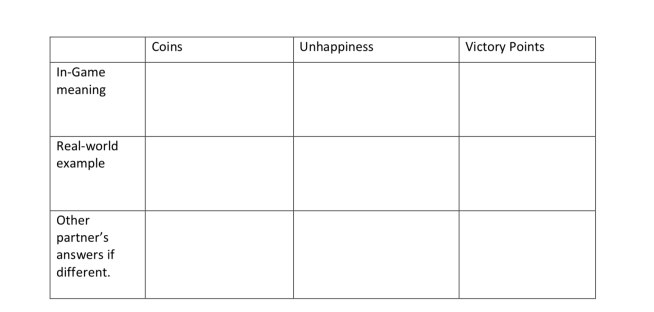
Examine – Examine
With a different pair, groups will compare their understanding of the assets in Flip City and if there are any different understandings. Any difference are noted in a whole-class discussion. Finally, students in their groups discuss each card individually. What are the assets? Does it make good game-sense to have the assets that way? real-world sense?
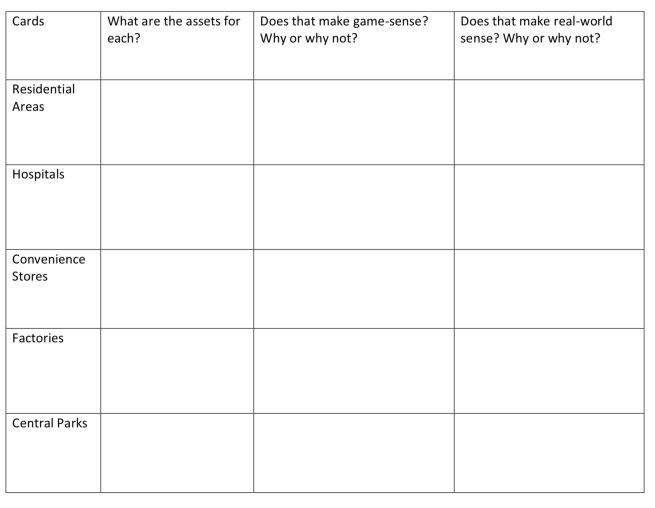
Examine – Extend
Finally, students in the groups of 4, play a game of Flip City. At the end of the game, students will take a picture of the winning player’s final Build Phase. Together they will analyze the city in terms of the game-world and real-world theme fitness. What kind of city is it? How many industries? retail services? public services? and so on.
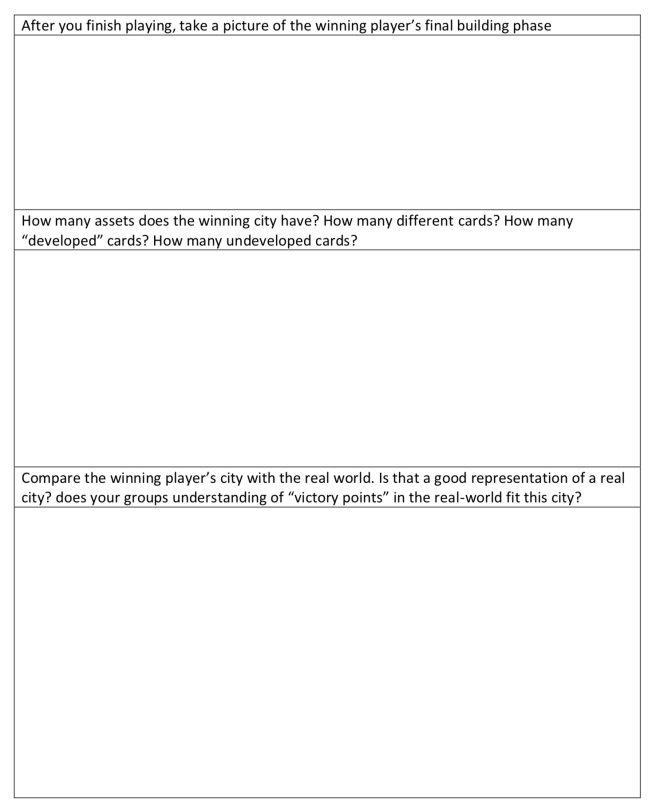
As a final homework project, students could be asked to look at a city with Google Maps and see if they can find representations of the “winning city” in a real city. An example from my home city:
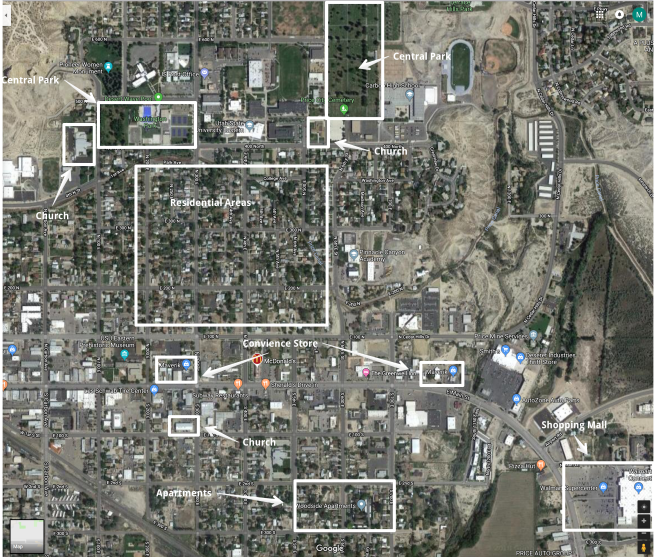
Students can judge their city based on the “Victory Point” conditions of Flip City. In the picture above, we can see that most of the residents live in “residential areas”, but there are some small apartments towards the south. How to decide how many RA cards are represented here would be up to individual discretion, but I would imagine all 4 RAs are represented here, with the one apartment. The City planners haven’t “flipped” or developed the residential areas in my small home town, and that’s actually about right.
At the same time however, in this one small picture there are three different churches (and there are a lot more out of frame). This means that unhappiness in this town is mitigated. Still no VPs however. The City has at least two parks, for 4 VPs, but it also has a “shopping center” (a walmart.. so.. I’m being generous). But in reality, that walmart was a big deal when it first opened in our small town and it is a major part of the city, well-represented by one VP. In total then, this picture represents 5 VPs. Just outside the city though, there are power plants. I’m not sure they pertain to this city in particular, but a lot of the citizens here do work for or around those power plants.
In the case of my classes, I would have the students share their edited city photos and explanations on a class forum and have them compare and contrast before the next class.
Conclusion
In the community of boardgamers, the “problem of VPs” comes up every so often. Some people do not like the abstracted representation, but many others rightly point out that the alternative to VPs is not always so great. Coup for example can have someone exit the game early and then they are forced to watch as the game unfolds. There are ways around this (The Resistance and One Night Werewolf solve it), but still, VPs can be useful in situations where what counts as “good” is not as clear, such as in the case of Flip City.
For L2TL, the question to me isn’t so much whether or not VPs are good, but what they can do for us in terms of learning. In the case of Flip City, which has a surprisingly disappointing thematic VP, we can leverage that to let students themselves discover what VP means in a city-building game and what it means to achieve “victory” in real-world city planning.
Some content on this page was disabled on February 12, 2020 as a result of a DMCA takedown notice from SahmReviews.com. You can learn more about the DMCA here:
